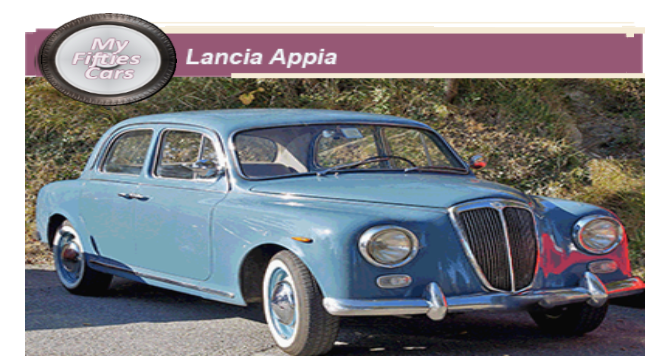
Lancia introduced their entry-level Appia saloon at the 1953 Turin Motor Show as was their practice with the four-door sedan version being the only model produced at the Turin plant.
The Appia was brought in as a replacement for the Lancia Ardea, long overdue for retirement having remained in production for more than fourteen years.
The Arde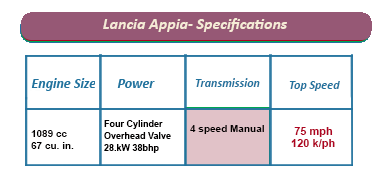 a was a compact saloon, powered by a four-cylinder 900-cc engine, reportedly the smallest ever produced.
a was a compact saloon, powered by a four-cylinder 900-cc engine, reportedly the smallest ever produced.
Other variations on the Appia, a two-door saloon and two doors convertible, were produced for Lancia by Vignale, who enjoyed a close working connection with the company throughout the Fifties.
 In keeping with the image that Lancia wanted to project with the Appia series, there was even a three-door station wagon known as the Giardinetta, this time produced by Turin-based coachbuilder Carrozzeria Viotti.
In keeping with the image that Lancia wanted to project with the Appia series, there was even a three-door station wagon known as the Giardinetta, this time produced by Turin-based coachbuilder Carrozzeria Viotti.
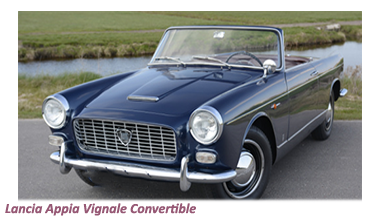 Viotti, while not being among Lancia's major coachbuilding service suppliers, had a long-standing relationship with the company responsible for the design and production of the iconic Dilambda Carlton Tourer, released in 1930.
Viotti, while not being among Lancia's major coachbuilding service suppliers, had a long-standing relationship with the company responsible for the design and production of the iconic Dilambda Carlton Tourer, released in 1930.
Initially, the Lancia Appia powered by a 1090-cc four-cylinder engine that produced 38 bhp, had that power increased to 43.5 bhp as the public began to expect more acceleration from their Appias.
![]()
Lancia’s expectations were met with the Appia's re-bored engine capable of pushing the car to speeds of up to 120 k/ph (75 mph).
The Appia engine was linked to a four-speed manual gearbox, with its lever conveniently placed on the dashboard.
In an attempt to increase speed by cutting down surplus weight, the first few thousand Appia sedans produced were fitted with aluminium, bumpers, rear wings and doors.
While their intentions were of the best, Lancia was soon made aware that the aluminium fenders proved to be problematic as they were very easily dented.
A prob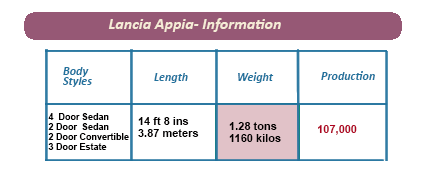 lem that Lancia's design team soon sorted out by adding rubber stripping which prevented most of the damage.
lem that Lancia's design team soon sorted out by adding rubber stripping which prevented most of the damage.
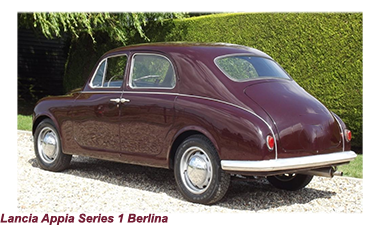 Making the best out of a bad situation, Lancia added thick surround moulding to the Appia's distinctive heart-shaped grille, nicely offsetting the grille's delicate vertical bars and more massive centre divider bar.
Making the best out of a bad situation, Lancia added thick surround moulding to the Appia's distinctive heart-shaped grille, nicely offsetting the grille's delicate vertical bars and more massive centre divider bar.
In a tradition going back to the Thirties, the Appia was fitted with front-hinged front and rear-hinged rear doors which made getting in and out of the car a lot easier, as well as adding to the car's a dramatic look by its absence of central pillars
 Inside there were independent front seats, covered in either grey or beige coloured wool cloth upholstery, nicely offsetting the Appia's ivory plastic steering wheel and switches, and
Inside there were independent front seats, covered in either grey or beige coloured wool cloth upholstery, nicely offsetting the Appia's ivory plastic steering wheel and switches, and
Just over twenty thousand Series One Lancia Appias were produced in its three-year production run 1953 to 1956.
![]()
The twenty thousand Appias, produced with either left or right-hand drive, were almost equally proportioned at ten thousand for each side of the road.
 The Appia was the last of the post-war Lancias to be fitted with the automaker's innovative sliding pillar front suspension design, which made for handling much more efficient and even sportier than the sedan's modest family sedan styling might have suggested.
The Appia was the last of the post-war Lancias to be fitted with the automaker's innovative sliding pillar front suspension design, which made for handling much more efficient and even sportier than the sedan's modest family sedan styling might have suggested.
The Geneva Motor Show in the spring of 1956 witnessed the launch of the Series II Appia, with a number of changes engineered by Lancia's recently appointed technical director Antonio Fessia.
The se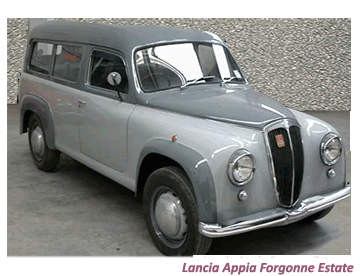 cond series Appia, was fitted with a more powerful engine had its body updated slightly making for an increase in interior space.
cond series Appia, was fitted with a more powerful engine had its body updated slightly making for an increase in interior space.
While the Appia Sedan was plodding steadily along in sales, in 1957 the release of the Vignale-designed and -produced cabriolet added a whole new pep to the Appia label.
 Designed by Giovanni Michelotti, the Appia Cabriolet, based on the second series Appia platform, was initially available as a two-seater, with 2+2 and coupes versions following later.
Designed by Giovanni Michelotti, the Appia Cabriolet, based on the second series Appia platform, was initially available as a two-seater, with 2+2 and coupes versions following later.
The Lancia Appia played its part in Lancia's success story of the Fifties and the early part of the Sixties. It was dropped from the range in 1963 after a ten-year production run to be replaced by the Lancia Fulvia,
During those ten years, over 100,000 Appias were sold, the vast majority of them sedans.
Got a question, a comment, a suggestion or an offer??? - FEEL FREE TO CONTACT US ANYTIME!!
Recalling the iconic cars of the Fifties and Sixtiesera and the visionaries that produced them - as well as a guide to acquiring, restoring and maintaining UK or European Classic Cars.
Take me back to the Home Page
EU6
